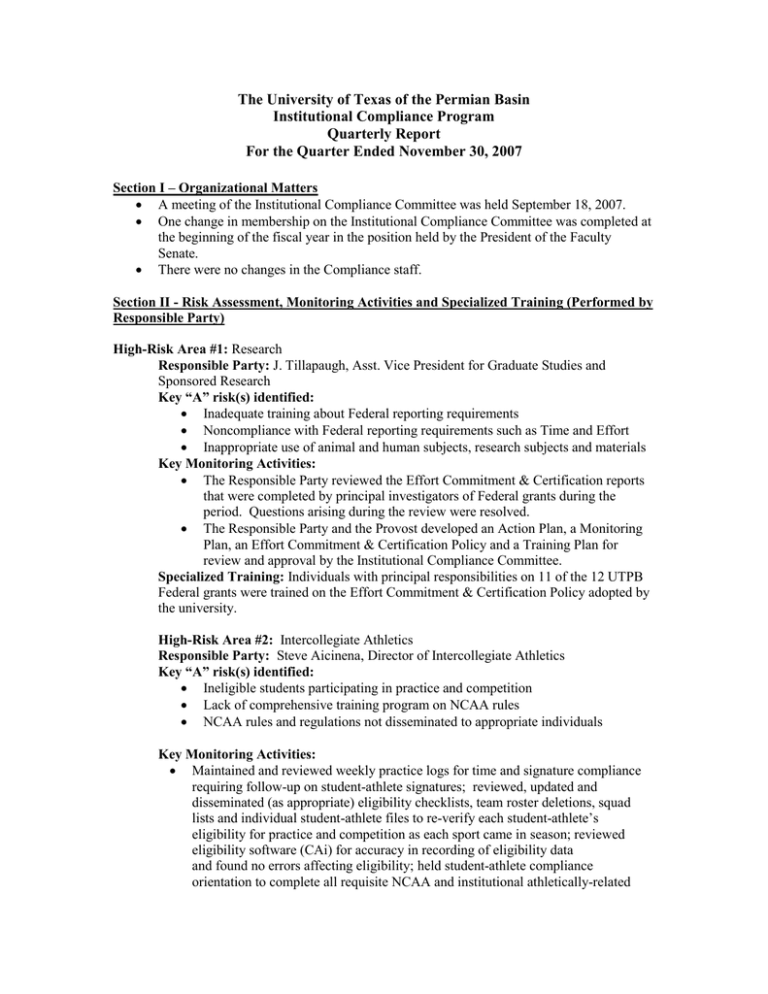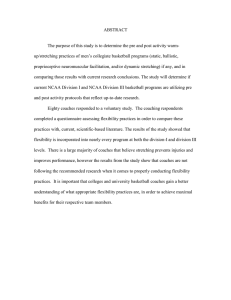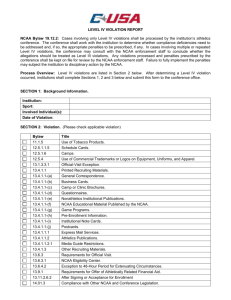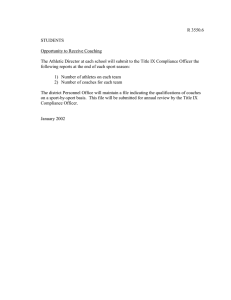First Quarterly Report FY 2008
advertisement

The University of Texas of the Permian Basin Institutional Compliance Program Quarterly Report For the Quarter Ended November 30, 2007 Section I – Organizational Matters A meeting of the Institutional Compliance Committee was held September 18, 2007. One change in membership on the Institutional Compliance Committee was completed at the beginning of the fiscal year in the position held by the President of the Faculty Senate. There were no changes in the Compliance staff. Section II - Risk Assessment, Monitoring Activities and Specialized Training (Performed by Responsible Party) High-Risk Area #1: Research Responsible Party: J. Tillapaugh, Asst. Vice President for Graduate Studies and Sponsored Research Key “A” risk(s) identified: Inadequate training about Federal reporting requirements Noncompliance with Federal reporting requirements such as Time and Effort Inappropriate use of animal and human subjects, research subjects and materials Key Monitoring Activities: The Responsible Party reviewed the Effort Commitment & Certification reports that were completed by principal investigators of Federal grants during the period. Questions arising during the review were resolved. The Responsible Party and the Provost developed an Action Plan, a Monitoring Plan, an Effort Commitment & Certification Policy and a Training Plan for review and approval by the Institutional Compliance Committee. Specialized Training: Individuals with principal responsibilities on 11 of the 12 UTPB Federal grants were trained on the Effort Commitment & Certification Policy adopted by the university. High-Risk Area #2: Intercollegiate Athletics Responsible Party: Steve Aicinena, Director of Intercollegiate Athletics Key “A” risk(s) identified: Ineligible students participating in practice and competition Lack of comprehensive training program on NCAA rules NCAA rules and regulations not disseminated to appropriate individuals Key Monitoring Activities: Maintained and reviewed weekly practice logs for time and signature compliance requiring follow-up on student-athlete signatures; reviewed, updated and disseminated (as appropriate) eligibility checklists, team roster deletions, squad lists and individual student-athlete files to re-verify each student-athlete’s eligibility for practice and competition as each sport came in season; reviewed eligibility software (CAi) for accuracy in recording of eligibility data and found no errors affecting eligibility; held student-athlete compliance orientation to complete all requisite NCAA and institutional athletically-related documentation; and followed-up on student signatures and reminded one studentathlete to complete lab tests for required reporting to Drug Free Sport in January 2008. No NCAA Self-Report Violations involving student-athlete eligibility were filed during the first quarter. Revised 4-Year Transfer Eligibility Checklist to better communicate eligibility issues to Head Coaches Created a Try-Out guide based on NCAA Bylaws for Coaches regarding the participation of current student-athletes in try-outs Created a Try-Out Form for Coaches that tracks NCAA Bylaws to accompany Official and Un-official Visit forms Expanded the NCAA Division II Coaches Recruiting Guide to further assist Coaches in following NCAA Bylaws during the recruiting process Adapted another institution’s form for Coaches to record recruiting information for later input to CAi Collaborated with staff to create scholarship award procedure flowchart for NCAA Bylaw Article 15 Financial Aid accountability and improve communication with Coaches and the Financial Aid Office Disseminated NCAA sport-specific recruiting calendar information to Coaches Forwarded NCAA and Conference updates to related institutional departments. Specialized Training: November 2007: Held Athletic Department meeting led by Athletic Director and attended by Staff, Compliance Officer, all Head and some Assistant Coaches of each sport, and the Faculty Athletic Representative. Of 21 eligible for training, 16 were actually trained. Those not attending were 4 Assistant Coaches and the Athletic Trainer. Training program was on NCAA Bylaw Article 13.02.1 Community Engagement Activity, recruiting and scholarship funds, importance of timely and accurately recording recruiting information in CAi, and pre-requisites for a letter of intent or scholarship issuance. Attendees were informed of upcoming NCAA External Compliance Review (March 5-6, 2008) and each person’s role in obtaining a successful review. Coaches were given a December 31 deadline to pass the NCAA Coaches Certification Exam as required by NCAA Bylaw Article 11.5 Certification to Recruit Off Campus. As of this date all but one (7 out of 8) have passed the exam. Section III – Monitoring and Assurance Activities (Performed by Compliance Office/Designate) High-Risk Area: Inadequate financial information to establish current position and close out prior year; Bad financial rating status; Failure to achieve budget assumptions Assessment of Control Structure: Opportunity for enhancement Monitoring/Assurance Activities Conducted: Financial audit of Fiscal Year 2007 Annual Financial Report. Significant Findings: Opportunities for improvement of controls over financial reporting were noted during the audit. Some of the recommendations were repeat recommendations from prior years. None of the findings had a material effect on the financial statements. Monitoring/Assurance Activities Conducted: Compliance Officer and Internal Auditor/Asst. Compliance Officer meet weekly with the President, Provost and Director of the Office of Accounting to review current financial position and potential actions that could impact year end results and financial rating status. High-Risk Area: Research Assessment of Control Structure: Opportunity for enhancement Monitoring/Assurance Activities Conducted: The Institutional Compliance Committee reviewed and approved the Action Plan, Monitoring Plan, Effort Commitment and Certification Policy and Training Plan developed to move toward compliance with the requirements of UTS 163 and to satisfy audit recommendations received in an August 2007 audit report related to compliance with UTS 163. High-Risk Area: All “Top 20” risks Assessment of Control Structure: Opportunity for enhancement Monitoring/Assurance Activities Conducted: A review of the monitoring plan for each of the “Top 20” risks was started in order to identify areas of potential improvement. Section IV – General Compliance Training Activities Six modules of General Compliance training administered through Training Post were assigned to all continuing employees. New employees were assigned twelve General Compliance modules. December 31, 2007 is the date set by the Institutional Compliance Committee for the assigned training to be completed. As of the end of the first quarter of fiscal year 2008, 1,088 of the 1,956 modules assigned or 55.6% were completed. Follow-up reminders from the appropriate executive staff will be used to remind staff to comply with the deadline. Section V – Action Plan Activities The following Action Plan items were implemented during the quarter just ended: Surveys were completed by the Committee to assess the compliance program and the compliance officers. A self-assessment survey of the program was completed by the Compliance Officer. The Compliance program, Compliance Committee, and Compliance function were assessed to ensure continual improvement. The Committee requested individual certification letters from all budget heads and responsible parties that provide assurance and/or note exceptions to compliance activities and programs within each area. The Assistant Compliance Officer participated in UT System Institutional Compliance Advisory Council (“ICAC”) and the Peer Review and Assurance Activities Committee. Provided monthly reports during the first quarter and the annual report for FY 2007 to the U.T. System office. Held a meeting of the Institutional Compliance Committee during the quarter. Completion of the following Action Plan items scheduled for the first quarter of FY 2008 were delayed until subsequent quarters due to other projects that demanded the attention of the Assistant Compliance Officer: The Committee will obtain final approval and distribute the revised Compliance Manual to appropriate staff. Monitoring plans for the top risks will be reviewed by the compliance officers and completed plans will be presented to the Compliance Committee for review.


